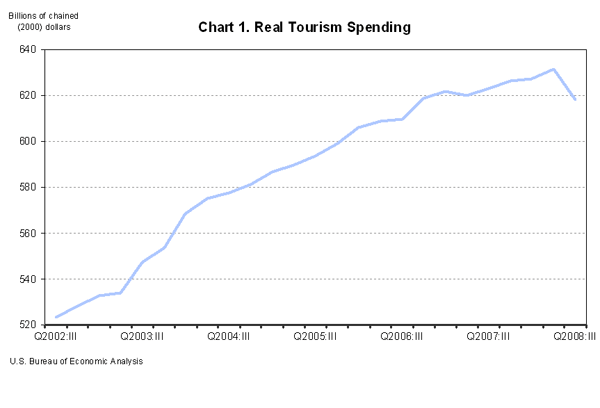* See the navigation bar at the right side of the news release text for links to data tables,
contact personnel and their telephone numbers, and supplementary materials.
Real spending on travel and tourism (spending adjusted for price changes) turned down sharply in 2008:3, decreasing at an annual rate of 8.1 percent—the largest decline since 2001:4. In 2008:2, real spending grew 2.8 percent (revised). By comparison, real gross domestic product (GDP) declined at an annual rate of 0.5 percent (preliminary) in 2008:3 after growing 2.8 percent in 2008:2.
- Passenger air transportation led the downturn—decreasing 20.4 percent in 2008:3 after decreasing 18.7 percent (revised) in 2008:2. Real spending on international flights fell sharply after two quarters of strong demand; spending on domestic flights declined for the fourth consecutive quarter.
- Spending on accommodations turned down, decreasing 3.0 percent in 2008:3 after a strong 19.5 percent increase in 2008:2. Hotel occupancy fell and room rates rose as hotels eliminated discounts intended to boost demand.
- Retail shopping by travelers dropped for only the second time in the past 3½ years, decreasing 6.9 percent in 2008:3 after increasing 4.7 percent (revised) in 2008:2.

Travel and tourism prices accelerated overall, increasing 10.6 percent in 2008:3 following a 6.2 percent increase (revised) in 2008:2. Transportation prices accelerated—increasing 18.4 percent after increasing 14.7 percent. Prices for accommodations turned up, increasing 5.0 percent after decreasing 6.5 percent.
Employment supported directly by tourist spending fell 1.2 percent in 2008:2 (the most recent period for which data are available) (1). The decline was widespread. In 2008:1, employment grew by 1.0 percent (revised). By comparison, overall U.S. employment decreased 0.6 percent in 2008:2 and 0.3 percent in 2008:1.

transportation increased 13.6 percent in 2008:3 after increasing 22.6 percent (revised) in 2008:2. To recover increases in fuel costs, airlines raised fares and reduced flights. Prices for accommodations increased 5.0 percent after falling 6.5 percent. In 2008:2, many hotels offered discounts to boost demand; however, prices rose in 2008:3.

ation services decreased 1.3 percent in 2008:2 after increasing 5.0 percent in 2008:1, marking the first decline after seven consecutive quarters of growth. Employment in accommodations fell 1.4 percent.

Total Tourism-Related Spending. The U.S. production that tourism spending generates not only includes the goods and services that are purchased directly, but also the inputs used to produce these goods and services—indirect tourism-related spending. In 2008:3, total current-dollar tourism-related spending of $1.4 trillion consisted of $797.8 billion (57 percent) of direct tourism spending—goods and services sold directly to visitors—and $613.6 billion (43 percent) of indirect tourism-related spending—goods and services used to produce what visitors buy.
Total Tourism-Related Employment. In 2008:2, total tourism-related employment of 8.6 million consisted of 5.9 million (69 percent) direct tourism jobs—jobs where workers produce goods and services sold directly to visitors—and 2.7 million (31 percent) indirect tourism-related jobs—jobs where workers produce goods and services used to produce what visitors buy.
1 Employment statistics are based on the Quarterly Census of Employment and Wages from the Bureau of Labor Statistics. Employment statistics for 2008:3 will be available in BEA’s Travel and Tourism Satellite Accounts’ March 19, 2009 press release.
Definitions
Tourism spending. Tourism spending comprises all goods and services purchased by tourists (defined as people who travel for any reason.). In the following tables, tourism spending is referred to as direct tourism output.
Indirect tourism-related spending. Indirect tourism-related spending comprises all output used as inputs in the process of producing direct tourism output (e.g., toiletries for hotel guests and the plastic used to produce souvenir key chains).
Total tourism-related spending. Total tourism-related spending is the sum of direct tourism spending and indirect tourism-related spending.
Direct tourism employment. Direct tourism employment comprises all jobs where the workers are engaged in the production of direct tourism output (such as hotel staff, airline pilots, and souvenir sellers).
Indirect tourism-related employment. Indirect tourism-related employment comprises all jobs where the workers are engaged in the production of indirect tourism-related output (e.g., employees of companies that produce toiletries for hotel guests and the plastic used to produce souvenir key chains).
Total tourism-related employment. Total tourism-related employment is the sum of direct tourism employment and indirect tourism-related employment.
These estimates are from BEA’s Travel and Tourism Satellite Accounts (TTSAs), which are supported by funding from the Office of Travel and Tourism Industries, International Trade Administration, U.S. Department of Commerce. The current-price estimates of direct tourism output were derived from BEA’s annual TTSAs (revised in June 2008) and from current-price quarterly estimates of personal consumption expenditures from the NIPAs. The constant-price estimates of direct tourism output were developed using price indexes from the Bureau of Labor Statistics (BLS) and constant-price quarterly estimates of personal consumption expenditures from the NIPAs. The estimates of direct tourism employment were derived from the annual TTSAs (revised in June 2008) and the Quarterly Census of Employment and Wages from BLS. Employment data are available five to six months after the end of the reference quarter.
Quarterly estimates are seasonally adjusted and expressed at annual rates, unless otherwise specified. Percent changes are calculated from unrounded data and annualized. “Real” estimates are in chained (2000) dollars. Price indexes are chain-type measures. Growth in overall U.S. employment is calculated using BLS Total nonfarm employment from Current Employment Statistics, www.bls.gov/ces/home.htm#data.
* * *
Next release –Travel and Tourism estimates for fourth quarter 2008 will be released on Thursday, March 19, 2009 at 8:30 a.m. EDT.
BEA’s national, international, regional, and industry estimates; the Survey of Current Business; and BEA news releases are available without charge on BEA’s Web site at www.bea.gov. By visiting the site, you can also subscribe to receive free e-mail summaries of BEA releases and announcements.





